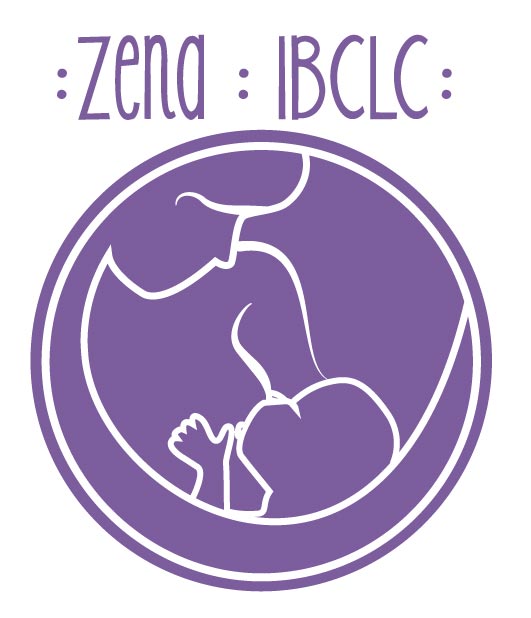: BREASTFEEDING HOW TO'S :
HOW BABY SHOULD LATCH ON:
Latching your baby on the right way is so very, very important. Both for baby, to assure they get the most milk possible, and for mama, to make certain that there is no discomfort, and mama's breast and nipple stay healthy and pain free. If you have any questions about latching your baby on, please feel free to contact me!
It is vital that your enviornment be one of comfort and support, so that you and baby have the best chance for success!
| 1. Baby Lightly Clothed. An overdressed baby will fall asleep fast at the breast, increasing the challenge of getting a good feeding. Maximize bare skin-to-skin contact, as this is vital to the baby's overall health, demeanor, and well being. Good skin-to-skin contact also increases mother's milk supply. 2. Good Support! You want your baby to be even with your breast, not laying low down in your lap. You do NOT want to lean over the baby to feed the baby. You want to be leaning slightly back, semi-reclined and comfortable. Again, skin to skin. Lift your shirt, don't just nurse through the opening in your nursing top if at all possible. If possible, remove your bra (when at home for instance) and get maximum skin to skin with your baby. Remember, your breast is not a bottle. Don't try to hold your breast in such a way that you are attempting to bottlefeed your baby your breast. |
|
| 3. Draw baby near to you. Tummy to tummy, skin to skin. As much contact between mother and baby as possible. 4. Speak soothingly to your baby. |
|
The success of the latch is based on 3 things: 1. Good positioning, SKIN TO SKIN, Nose to nipple, wait for baby to raise her chin to latch on!2. Good support 3. A WIDE mouth on the babyErect your nipple and then tickle baby's upper lip and the tip of baby's nose with the end of the nipple until baby opens the mouth WIDE. If you are using a nipple shield, use the end of the shield to tickle the top lip. Once the mouth gapes wide, allow the baby to discover the breast, Nose to nipple. When baby opens, bring baby chin first, to achieve the latch on. We do not want baby latching on to the nipple only. Baby needs areola also in order to remove milk effectively from the breast. It is NOT necessary to get ALL of the areola into the baby's mouth, but you want to see more of the lower areola in the baby's mouth, a smooth rhythmic suckle, and swallowing. |
|
Remember, latch on can feel "odd" but it is not supposed to feel bad. Pain is an indicator that the latch is not right. Unlatch baby with your pinkie finger, and try again. If you simply cannot get the baby to latch well, please call me for help. Latched!Once the latch is achieved, the baby will begin drinking. Be sure to watch the video's linked on this page to witness what this looks like first hand. A baby that is latched well and drinking well, will not fall asleep immediately at the breast. Things to look for in a well latched baby:
|
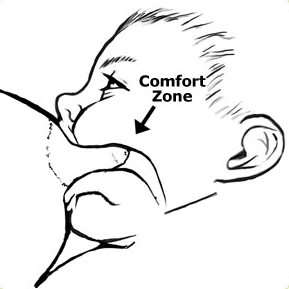 |
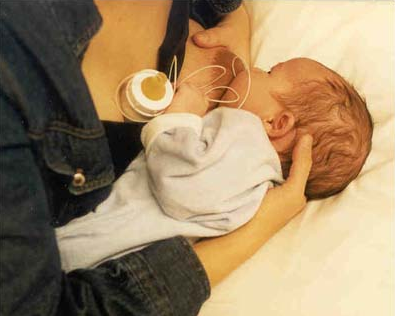 |
Using a Supplemental Nursing System, this baby feeds well at the breast! |
| Another video shows how breastfeeding is natural for a new born baby. |
HOW TO POSITION YOUR BABY:
Proper positioning and body/baby support is vitally important to latch on success, and comfortable breastfeeding. Many cases of nipple pain can be directly related to the baby being held improperly. Below you will see demonstrated the most common positions in which to breastfeed your baby.
The Football or "Clutch" Hold
This is a handy hold for most newborns. Not only does it give the mother a good view of what she is doing, it works well to achieve good eye contact between mother and child. It is also wonderful for low weight babies as well as large babies. It gives the mother good control over her breast, and gives a comfortable snuggle for baby as well. This hold is also a good choice for C-section mama's.

HOW TO:
Hold the breast with your opposite hand in a "C" shaped hold, thumb on top of the areola, and the rest the fingers underneath the breast, to present the breast to the baby. Baby should be tucked in close to mother, with one hand tucked in close to the mother's body to prevent the hand from being in the way during latch on. Mother's outer arm should be snug to the baby, with her hand at the base of the baby's head/neck. Once baby is gaping wide, bring baby quickly YET GENTLY to the breast to achieve latch. Baby should latch chin first, obtaining more of the lower areola than the upper in his mouth. Visualize how you take a bite out of a thick sandwich, this is similar to how baby goes to the breast for latch on. In this order, mouth wide, bottom lip, tongue, top lip. Latched!
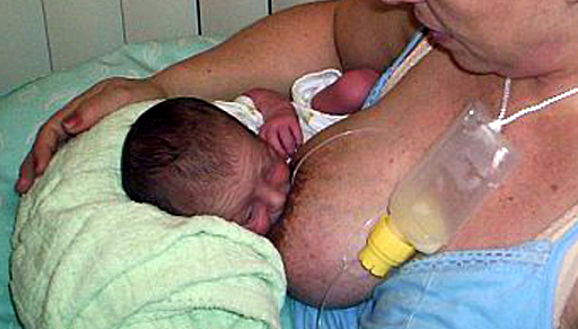
The device you see around the necks of these two moms is called a Medela Supplemental Nursing System. Both mom are using the device to get additional milk to their baby while breastfeeding because they are working on bringing up a low milk supplty. Both mom breastfed the babies you see here past 1 year.
The Cross Cradle Hold AKA The Asymmetrical Latch
This is my absolute favorite and most used hold for moms, because unlike the football hold, it provides absolute comfort for mother, both with her body and her breasts, and it also allows baby to feel fully in control over her own feeding, and she feels secure resting on top of the breast, rather than desperately trying to maintain latch while laying UNDER the breast. This hold works beautifully for almost all breast sizes, and works fantastically for c-section AND vaginal birth moms, even with stitches! MAKE SURE THAT YOU ARE LEANING BACK in your favorite reclining chair, or in the corner of your sofa, on top of pillows on your bed, and are comfortably reclined, so that your baby can rest across your breasts, her body laying fully across the tops of your breasts. Baby should NOT BE laying low and under the breast, but across the breast, with the breast she will be suckling from between her two arms, and the breast she is not suckling from between her two legs. Her belly button should be touching your body. If it's not, continue to rotate her hips around until it is.
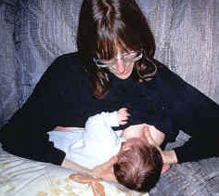
HOW TO:
Lay the baby across your breasts, in the way described above. If nursing on your right breast, use your right hand to cup the breast using the "U" hold, meaning, your hand is fully UNDER the areola, and your open cupped hand forms a U shape between your thumb and first finger around the areola (The dark part of skin around your nipple). The other arm goes across the baby's back, coming in between the baby's legs to give good control of baby's bottom, with gentle control at the base of the head/neck. Wait for baby to gape open wide, helping baby along by tickling the baby's TOP lip with your erect nipple. Once baby opens wide, you're ready to latch! See photo's below!
The Cradle Hold (Traditional Hold)
You can move to this hold once the Asymmetrical latch has been achieved as described above, by slowly letting go on the breast with your hand (SLOWLY AND GENTLY!) bring your arm around so that baby lays on your arm. WE DO NOT START OUT NURSING A NEWBORN IN THIS POSITION. An older baby can easily start out nursing this way, but this is very difficult for a newborn. It is best to begin with the Asymmetrical latch, and then slowly move your arm around AFTER latch is well achieved and baby is happily nursing.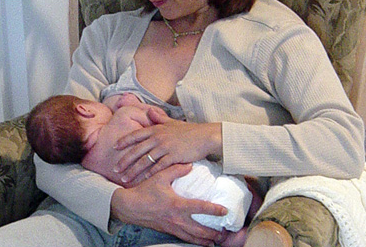
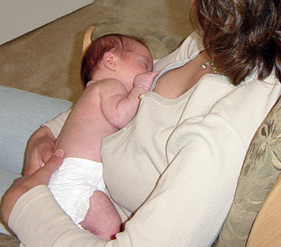
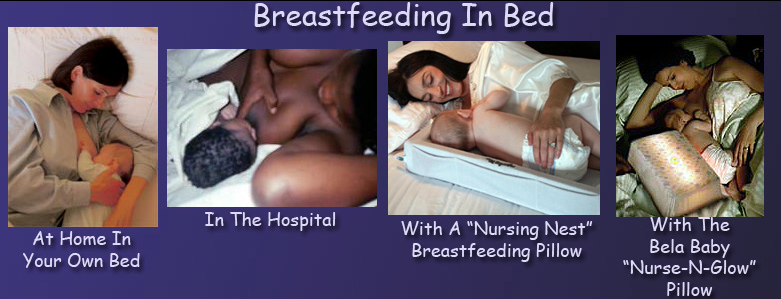
Breastfeeding In The NICU....It Can Be Done!
If you are unable to pick your baby up, you CAN still breastfeed your baby, as long as baby is in an open top crib or can be moved to one. You will use the same basic principles as seen above for the Asymmetrical latch, the difference being that you will be standing. Just make sure that your body is VERY close to baby. Once your baby can be held in your arms, there is no reason whatsoever that you cannot put your baby to the breast to feed. It is best to do these first feeds with the help of a Lactation Professional, not just an RN from the NICU. Please feel free to call me for help anytime, day or night. See the photos below for inspiration! |
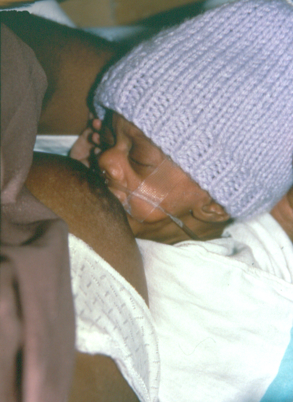 |
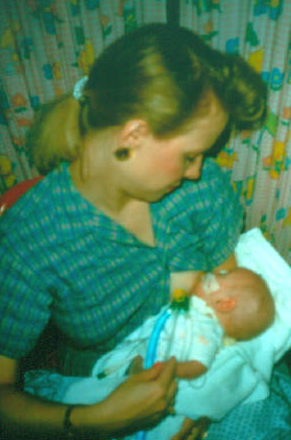 |
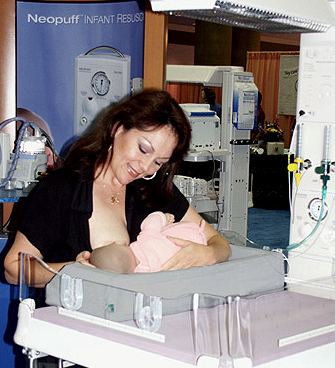 |
If you have not grown up watching mothers breastfeeding their babies, it may be difficult or challenging emotionally if things don't come "naturally" to you. The great thing about seeking support to nurse your baby is that you will never feel alone, left to figure things out on your own. Call me for help, I am here for you, ready to be there for you to support you in success!
We'll work it out together!